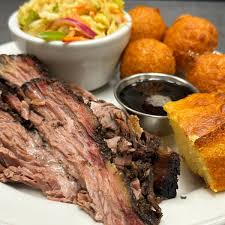Brisket, a cut of beef from the chest of the animal, has become a beloved barbecue staple, particularly in the southern United States. The slow-cooked, smoky flavor of brisket has captivated taste buds and made it a centerpiece of many backyard gatherings and barbecue competitions.
The Art of Brisket Smoking
Smoking brisket is a time-consuming process that requires patience and attention to detail. The key to achieving the perfect smoky flavor lies in the slow cooking over low heat, allowing the meat to break down and become tender.
The smoking process typically involves the following steps:
- Preparation: The brisket is trimmed of excess fat and rubbed with a dry seasoning mixture, often consisting of salt, pepper, garlic powder, onion powder, and other spices.
- Smoking: The brisket is placed on a smoker and cooked over low heat for several hours, often overnight. The smoke from the wood chips or chunks used as fuel imparts a distinctive flavor to the meat.
- Resting: Once the brisket reaches its desired internal temperature (typically around 200-205 degrees Fahrenheit), it is removed from the smoker and allowed to rest for at least 30 minutes. This resting period allows the juices to redistribute throughout the meat.
The Perfect Brisket: A Balance of Flavor and Texture
A perfectly cooked brisket is characterized by its tender, juicy meat and its smoky, savory flavor. The bark, the crusty outer layer that forms during the smoking process, should be dark and flavorful.
The key to achieving the perfect balance of flavor and texture lies in the smoking process. Slow cooking over low heat allows the connective tissue in the brisket to break down, resulting in a tender and juicy meat. The smoke from the wood chips or chunks adds a depth of flavor that is essential to a great brisket.
Brisket Variations and Pairings
While the classic brisket recipe remains popular, there are many variations that cater to different tastes and preferences. Some variations include:
- Spicy brisket: Adding chili peppers or hot sauce to the seasoning rub can give the brisket a spicy kick.
- Sweet and savory brisket: Sweet and savory sauces, such as barbecue sauce or molasses, can be applied to the brisket during the final stages of cooking.
- Rubbed brisket: Experimenting with different seasoning rubs can create unique flavor profiles.
Brisket is often served with a variety of sides, including coleslaw, baked beans, potato salad, and cornbread. It can also be used in sandwiches or tacos.
Brisket and Barbecue Culture
Brisket has become a symbol of barbecue culture in the southern United States. It is often the centerpiece of backyard gatherings and barbecue competitions. The art of smoking brisket has been passed down through generations, and it continues to be a beloved tradition.
Whether you’re a seasoned barbecue enthusiast or a newcomer to the world of grilling, smoking a brisket is a rewarding experience that will leave you with a delicious and unforgettable meal.
